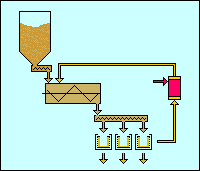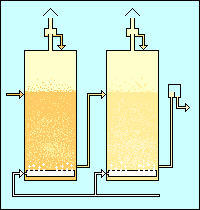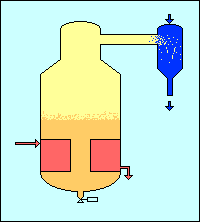How Sugar is Refined - the Basic Story
Raw sugar is made in tropical countries where sugar cane can be grown profitably. It is then shipped in bulk to a refinery in the country where the sugar is required. It now has to be finally cleaned up, purified and made ready for the consumer.

It helps to think of refining as a series of steps from left to right where colour and non-sugars are concentrating to the left and pure sugar is concentrating to the right. However the raw sugar comes into the process to the left of centre, not at one end. In the description that follows the flow of sugar is followed first and then the remainder of the process is reviewed.
Affination
The first stage of processing the raw sugar is to soften and then remove the layer of mother liquor surrounding the crystals with a process called "affination". The raw sugar is mixed with a warm, concentrated syrup of slightly higher purity than the syrup layer so that it will not dissolve the crystals. The resulting magma is centrifuged to separate the crystals from the syrup thus removing the greater part of the impurities from the input sugar and leaving the crystals ready for dissolving before further treatment.
The liquor which results from dissolving the washed crystals still contains some colour, fine particles, gums and resins and other non-sugars. |  | |  |
 | Carbonatation
The first stage of processing the liquor is aimed at removing the solids which make the liquor turbid. Coincidentally some of the colour is removed too. One of the two common processing techniques is known as carbonatation where small clumps of chalk are grown in the juice. The clumps, as they form, collect a lot of the non-sugars so that by filtering out the chalk one also takes out the non-sugars. Once this is done, the sugar liquor is now ready for decolourisation. The other technique, phosphatation, is chemically similar but uses phosphate rather than carbonate formation. |  |
Decolourisation
There are also two common methods of colour removal in refineries, both relying on absorption techniques with the liquor being pumped through columns of medium.
One option open to the refiner is to use granular activated carbon [GAC] which removes most colour but little else. The carbon is regenerated in a hot kiln where the colour is burnt off from the carbon. The other option is to use an ion exchange resin which removes less colour than GAC but also removes some of the inorganics present. The resin is regenerated chemically which gives rise to large quantities of unpleasant liquid effluents.
|  | | The clear, lightly coloured liquor is now ready for crystallisation except that it is a little too dilute for optimum energy consumption in the refinery. It is therefore evaporated prior to going to the crystallisation pan. |  |
 | Boiling
In the pan even more water is boiled off until conditions are right for sugar crystals to grow. You may have done something like this at school but probably not with sugar because it is difficult to get the crystals to grow well. In the factory the workers throw in some sugar dust to initiate crystal formation. Once the crystals have grown the resulting mixture of crystals and mother liquor is spun in centrifuges to separate the two, rather like washing is spin dried. The crystals are then given a final dry with hot air before being packed and/or stored ready for despatch. |  |
Recovery
The liquor left over from the preparation of white sugar and the washings from the affination stage both contain sugar which it is economic to recover. They are therefore sent to the recovery house which operates rather like a raw sugar factory, aiming to make a sugar with a quality comparable to the washed raws after the affination stage. As with the other sugar processes, one cannot get all of the sugar out of the liquor and therefore there is a sweet by-product made: refiners' molasses. This is usually turned into a cattle food or is sent to a distillery where alcohol is made. |  | |  |
Do you want to know more about sugar refining? Try RAR in Portugal at http://www.rar.pt.


|


